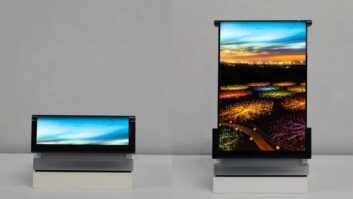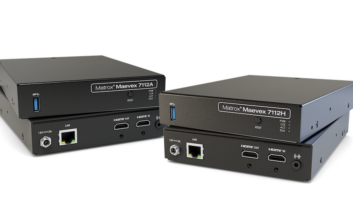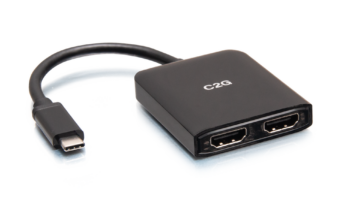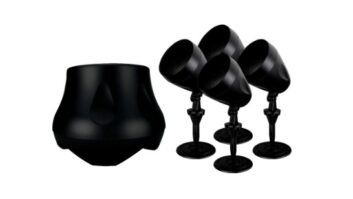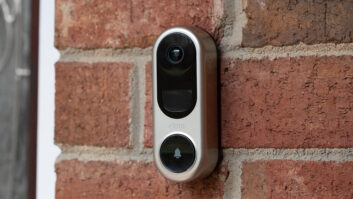Las Vegas – Audio suppliers hope to reverse the declining attachment rate of quality audio to big-ticket video-display sales with the launch here of component speakers whose graceful, trim cosmetics are as appealing as the cosmetics of flat-panel TVs.
The enhanced styling, suppliers contend, will help eliminate aesthetic objections from consumers who are attracted to flat-panel displays as much for their striking cosmetics as for their picture quality.
Dealers at the show will also find new home theater speaker packages and speakers whose cosmetics are intended strictly to enhance sound quality, not make a fashion statement.
‘A major retail challenge is attaching good audio to the new display technologies,’ said Definitive Technology president Sandy Gross. Speaker suppliers can contribute by ‘providing appropriate product from a styling, price point, and performance standpoint.’ All plasma TVs, he noted, ‘come with contemporary styling, so consumers need speakers with coordinated styling’ in on-wall, floor-standing, and table-standing versions, said Gross.
By late last year, only a handful of companies had been shipping speakers cosmetically designed to match new flat-panel displays, but this year, the selection will grow, he said. Dealers had just begin late last year to display plasma-friendly speakers in the plasma sections of their stores, Gross noted.
The steadily declining price of plasma TVs might also help turn around speaker sales, some suppliers suggested. Big-ticker plasma sales have sucked up disposable income, and ‘as plasma prices fall to $2,500, it will free up money for audio,’ Gross contended. ‘But even with a $10,000 plasma,’ he noted, ‘the key is to show appropriate product, and people will buy it.’
Better design is also turning up in speakers not specifically designed to complement the aesthetics of flat-panel displays. Some suppliers are even designing enclosed speakers purpose-built for placement inside AV cabinets so they can practically disappear.
‘Traditional audio suppliers, especially on the speaker side, have been slow to move as quickly as TV sets into contemporary design and look,’ said Eli Harary, Infinity’s sales and marketing VP. Some speakers, nonetheless, ‘are very contemporary,’ he noted.
Klipsch president Paul Jacobs said speaker suppliers must work harder to develop innovative designs. ‘We don’t see a lot of growth in the traditional boxes,’ he noted. ‘We think there’s a market for that and will be for a long time…Our investment is going into design, application, and usability.’
Here at the show, dealers will find a greater selection of more contemporary designs. Definitive Technology, for example, will expand its selection of recently introduced plasma-friendly Mythos speakers, and Klipsch and Thiel will launch their first plasma-friendly speakers.
Also at CES, Yamaha will unveil a single wall-hanging active speaker that delivers all channels of a 5.1-channel source. PSB will show its first speaker designed for placement inside an AV cabinet. Paradigm will unveil its highest end line to date. And JBL will launch its first 7.1-channel speaker packages.
Electronic enhancements will also turn up in more powered subwoofers to improve response. Infinity, for example, will expand the use of parametric equalization to overcome low-frequency room resonances that can reduce sonic accuracy.
Here’s a company-by-company summary of new speakers at the show:
Athena: The Audio Products brand will add a bipolar wall-mountable surround to its Audition series of small speakers with high efficiency and power handling. The AS-R1 dur in the first quarter at an expected suggested $125 each, features a 5.5-inch woofer flanked by a 1-inch dome tweeter on each side.
Definitive Technology: The company will expand its Mythos line of extruded-aluminum, plasma-friendly speakers with four more models, and it will replace three bipolar tower speakers that feature built-in powered subwoofers. Also new: silver versions of the Pro Cinema home theater sub/sat systems, designed to blend better with the high-tech styling of many new TVs.
The Mythos speakers ship in April. The new towers are due in March.
The original Mythos speakers, available since August, consist of one floorstanding tower, one on-wall/table-mount model, and one wall/table-mount center-channel speaker. Now, Definitive is adding smaller, less expensive models, expanding the Mythos selection to seven SKUs. Two new models are on-wall/table-mount models that, like the current models, come with stainless-steel wall-mount bracket and with optional tempered-glass tabletop-mounting base. The two are the Mythos Six left-right speaker and the Mythos Seven center channel, both priced at a suggested $399 each compared to the line’s current $499 opening price.
Two new floorstanding Mythos models, the Four and Five, at $699 and $499 each, respectively. They would be smaller and less expensive than the current $799 Mythos One tower.
In other changes, the company is using the term Super Towers to describe bipolar towers with built-in powered subwoofers. Three new SuperTowers in the 7000 series will replace three models in the 2000 series, maintain the same price points, but bring 7000 series technology to lower prices points. The three models are the BP7002, 7004, and 7006, each priced per side at $1,099, $799, and $599, respectively.
Compared to their predecessors, they deliver more sculpted styling, improved crossovers, and subwoofer technology derived from the company’s compact SuperCube subwoofers. The trio’s subwoofers use digital-switching amps, one active driver, and two passive drivers to extend each model’s 3dB downpoint by 10Hz compared to their predecessors. They also boast lower distortion and improved transient response. The crossovers provide a smoother blend between drivers and a more consistent amplifier load, especially at higher frequencies, the company said.
Although many companies have dropped towers speakers with built-in powered subwoofers, Definitive is sticking with the category, which it introduced to the market years ago. ‘Others have come and gone because they didn’t understand how to do it,’ said Definitive president Sandy Gross. Many of the products, for example, didn’t deliver full subwoofer performance, he said. ‘There are clear performance advantages and lifestyle advantages’ to such designs, he continued. ‘The subwoofer should be part of the main speaker to properly blend with the main speaker.’
Dual Electronics: The new DJ Series combines the look of pro monitors with rugged, black-carpeted construction and sturdy transport handles for easy movement from party to party. Five models ship in March.
Every model is designed to withstand the rigors of life on the road even if they spend all their time in a den or dorm room. Durable black carpeted enclosures provide protection from scuffs while adding a stylish and professional appearance.
To differentiate the DJ Series, all models but one model feature VU meter to display audio voltage levels from -30 to +3 dB in or out of a piece of equipment.
The top-end model is the four-way $179-suggested Dlil54ME, which measures 17×12.5×33.5 inches and weighs 46 pounds. It features VU meter, pulsating LED light surrounding the silver cone, and a glowing center-mounted Dual logo. The driver complement consists of a 15-inch woofer, horn-loaded 25mm piezoelectric tweeter, and dual horn-loaded 30mm piezoelectric tweeters. Frequency response is 28Hz – 20kHz, +/- 3dB. Recommended amplifier power is 10-400 watts. Sensitivity is rated at 84dB, and nominal impedance is 8 ohms.
Infinity: The company is replacing its Alpha series with Beta, which sports refined cosmetics, enhanced technology, but no increase in price from the comparable Alpha models.
The company is also expanding its selection of powered subwoofers with built-in parametric equalizer to overcome low-frequency room resonances that can reduce sonic accuracy.
The Betas, a step up from Infinity’s opening-price Primus series, are the company’s first speakers to extend response to 40kHz from 22kHz, pushing tweeter resonance outside the audible range. The result is smoother tweeter response and clear, open and detailed high-frequency response, the company said. To accomplish that, the speakers incorporate a newly improved version of the company’s CMMD (Ceramic Metal Matrix Diaphragm) tweeter, which is used in the flagship Prelude MTS models to enhance sonic accuracy and musicality with detail, smoothness, consistent sound quality throughout the frequency range.
They are also Infinity first speakers to incorporate a proprietary high-frequency waveguide that uses a series of computer-designed graduated curves that flare from the inside to the outside. The waveguide is said to improve on- and off-axis high-frequency dispersion and smoothness, increase sensitivity, and deliver a more seamless blend with the woofer and midrange drivers.
The Beta series consists of the Beta 10 two-way bookshelf at a suggested $165/each, the Beta 20 2-way bookshelf at $199/each, the Beta 40 three-way floorstander at $399/each, the Beta 50 three-way floorstander with dual eight-inch woofers at $499/each, the C250 two-way center channel at $299/each, the C360 two-way center channel speaker at $399/each, and the ES250 surround with selectable monopole/bipole/dipole/dual-speaker operation at $349/each.
The ES250’s dual-speaker mode enables it to function as two independent surround loudspeakers from one enclosure for use in small rooms.
Beta ships at the end of the first quarter in a variety of wood finishes with complementing grille colors, including black with black grilles, beech with platinum grilles, and cherry with platinum grilles. The ES250 is available in black or white pica finishes. All models (except the ES250) are magnetically shielded.
Like Alpha, Beta will be open to all Infinity retail channels, including Circuit City.
Also at CES, Infinity plans to introduce two compact powered subwoofers with proprietary Room Adaptive Bass Optimization System (R.A.B.O.S) technology, which uses a built-in parametric equalizer to iron out low-frequency room resonances. The $999-suggested CSW-10 features 10-inch woofer, built-in 650-watt amplifier, and the company’s exclusive Room Adaptive Bass Optimization System (RABOS), which packages the parametric EQ with a control kit that includes test CD, microphone, and SPL meter optimized for low-bass readings. Previously, RABOS powered subs strated at $1,699.
The $799-syggested SW-12 features 12-inch woofer, built-in 500-watt amplifier, and Infinity’s proprietary Bass Optimization System (BOS), which is RABOS without the control kit.
Innersound: The company is expanding its selection of hybrid electrostatic loudspeakers with the Neptune center channel, due in March with electrostatic operation down to 500Hz and a magnetic damping system combined with extended transmission-line bass chamber to deliver bass response to 35z . The output level is 115dB
Also new: a two-channel Reference amp in stereo and monoblock versions and a matching preamp, both due in April. Prices were unavailable.
The amp is designed to drive any loudspeaker without compromise at 450 watts per channel into 8 ohms, 900 watts per channel into 4 ohms (stereo version), 1000 watts into 8 ohms, and 2,000 watts into 4 ohms (monoblock version).
The preamp features three pairs of balanced inputs and outputs.
JBL: Targeting radically different market segments, JBL is launching its no-holds-barred Project Array home theater speakers and its first 7.1-channel home theater speaker packages.
Project Array consists of three large satellite speakers, a center channel and a powered subwoofer that adopt technologies from JBL’s ultra-high-end K2 speakers and from its professional recording studio monitors. The three-way satellites feature an unusual design intended to optimize response. Each features a freestanding horn-loaded tweeter that sits on top of a vertically oriented midrange horn driver that itself is freestanding and turn sits on top of a woofer cabinet. By eliminating an enclosure around the tweeter and midrange, JBL eliminates enclosure diffraction to deliver ‘exceptional imaging along with a wider, deeper, more three-dimensional soundstage,’ the company said. The center channel features two woofers flanking a vertical horn midrange/tweeter combo. A 15-inch powered sub is driven by a 1,000-watt Class D amplifier. The woofers in the satellites are 8-, 10-, and 14-inches, respectively.
The wood speakers are available in black-lacquered finish. Prices and ship dates weren’t available.
The SCS300 and SCS200 7.1-channel packages, priced respectively at $649 and $549, feature two-way satellites with 3.5-inch mid driver and 0.75-inch tweeter. Their center channel features dual 3.5-inch mids flanking the same tweeter. The difference is in the subwoofers, which is a 10-inch 200-watt model in the 300 and an 8-inch 100-watt model on the 200. They ship in the spring.
Klipsch: The company is expanding its Reference series of speakers with its first plasma-friendly models and an opening-price compact home theater speaker package. The series is targeted to AV specialists and custom installers.
For use with plasma and LCD displays, the company plans August shipments of the extruded-aluminum on-wall/table-mount RVX-42 and the floorstanding RVX-54. Their targeted suggested retails are $450 and $750 each, respectively. They will be available in black or silver finishes to match other Reference satellites. Both feature horn-loaded 1-inch dome tweeter.
The 42 is 24-inches-tall, feature two 4-inch aluminum woofers, and comes with dual-keyhole wall mounting, OmniMount wall-mount provisions, and a pedestal base that can position the speaker for horizontal center-channel or left-right use.
The 54 floorstander features four active 5.25-inch aluminum woofers.
The new Reference Cinema 6 package complements higher priced Cinema 8 and 10 systems at a suggested $950. The system, targeted to ship in June, consists of four RSX-3 monitors and the RCX-3 center channel, each with 0.75-inch horn-loaded tweeter, 3.5-inch aluminum woofer, and integrated pedestal stands with ball-joint adjustment. They can be wall mounted. They’ll be merchandised with the separately available RS-8 powered sub for a combined $950, but without the sub, the package will retail for a suggested $600.
Linn: The new high-end Akurate series consists of a five-way floorstanding speaker at $9,495 each, a stand-mountable four-way speaker at $5,750 each, a five-way center channel at $3,750, and a servo-controlled powered sub at $3,750. The satellites and center channel can be driven by traditional amplifiers or connected to Linn’s Aktiv system, which powers the speakers and converts their crossovers to active from passive operation.
Mission: A new company, Mission USA, has begun marketing the British brand’s speakers in the U.S., where high-end audiophile and home theater speakers and custom speakers will be available. At the show, the company will unveil three Elegante multichannel speaker systems intended to meet the demands of the DVD-Audio and SACD formats. Pricing was unavailable. Also new: five Volare series bookshelf, floorstanding, and center-channel models priced from $450 to $1,350. Both series ship in the first quarter.
Paradigm: The company is targeting the high and low end with a series of introductions that includes its highest end offering to date, the Reference Signature Series. It’s more than twice the price of Paradigm’s previous high-end offering, the Studio v.3 Series.
At the other end, company is launching its most affordable home theater speaker package to date, the Cinema 70 HTiB. It features five satellites and 8-inch subwoofer at $549. The two-way satellites, in black or silver, are 7×4.25×5.5 inches, and the subwoofer measures 14.5×9.75×13.75 inches. The satellites feature 5/8-inch tweeter and 3.5-inch woofer. The subwoofer amp delivers 90 watts RMS, and the subwoofer reproduces bass to 29Hz.
The Signature Series consists of two bookshelf speakers at $2,000 and $3,000/pair, a tower speaker at $6,000/pair, two center channels at $1,500 and $2,500 each, a surround pair at $2,700 with proprietary adapted dipole (ADP) technology, and a servo subwoofer at $3,500.
Signature uses a gold-anodized pure-aluminum to produce a rigid dome without adding mass. WaveGuide faceplate design delivers wide high-frequency dispersion with flat response.
A midrange chamber contributes to smooth, natural, accurate and balanced midrange performance with a greater level of detail, clarity and authenticity than competing ,models, the company claimed.
All speakers are available in four Highly Polished Exotic Wood Veneers—Rosewood, Piano Black Gloss, Natural Bird’s Eye Maple and Cherry.
Also new: The Reference series’ $1,600 Seismic 12 subwoofer. joining Paradigm’s Servo-15 . The 12-inch downfiring sub features dual high-velocity 10-inch passive radiators, die-cast aluminum chassis, and Class D amplifier delivering 1200 watts RMS (FTC rated). It offers level control, phase alignment, and adjustable bass contour. It’s available in black ash.
Polk: A new custom series and new powered sub will be displayed.
The LSiw sub, replacing the PSW650, ships in April at a suggested $1,199 with dual 10-inch drivers, 2-inch voice coils, 400-watt digital amp, phase switch, front-panel volume and variable low-pass controls, auto on/off, and unfiltered LFE input. It’s part of the LSi series.
PSB: The company is expanding its custom-install speaker and redesigning its Image series of enclosed speakers.
The new Image line-up, shipping in the first quarter, consists of eight new models, including three sets of towers, two sets of bookshelf monitors, two dedicated center channel speakers, and a bipole surround speaker, all of which can integrated with any PSB subwoofer. Each model in the series is timbrally and cosmetically matched.
The company improved performance in part by using metalized injection woofer cones in all models, instead of the previous models’ vacuum-formed cones, to ensure a higher consistency during the manufacturing process. The tweeter phase plug was adjusted to create a smoother high-end response. The crossover was also tweaked to enhance overall performance.
Cosmetics were changed dramatically with a soft, curved shape. It comes in maple finish with light gray grilles or black ash with black grilles.
Also on display: the Platinum Series, already shipping. It consists of two towers at $6,999 and $4,999/pair; two center channels at $1,999 and $1,499 each; a mini monitor at $1,999/pair, a bipolar surround, and a 10-inch powered sub at $2,499. They’re designed to be step-ups from Stratus series models while still offering value.
Several models, including the flagship T8 tower, use a D’Appolito array to deliver smooth response over an ‘unusually large horizontal and vertical sweet spot’ to provide ‘exceptionally open, lucid, and dynamic sound with superb clarity,’ the company said. The Subsonic 10 powered subwoofer features two 12-inch high power, long-throw woofers powered by an internal BASH, Class H amplifier yielding 500 watts RMS.
All Platinum speakers are available in real wood veneer with die-cast aluminum ends and extrusions.
RBH: New custom commercial speakers and a powered sub will be displayed. They’re already available.
The MS-10.1 subwoofer features technologies used in the flagship Signature series. They include proprietary aluminum driver and Tuned Aperiodic Vent, which is said to deliver lower frequency response than similarly sized vented enclosures. The technology elements, combined with 250-watt amp, deliver bass down to 22Hz.
Snell Acoustics: The new Series 7 speakers, due in the first quarter, was developed by speaker designer Dr. Joseph D’Appolito, who described his task as producing ‘a range of loudspeakers offering a new level of sonic accuracy and aesthetic appeal at affordable prices.’
Eight models start at $1,200/pair. They comprise a tower, three bookshelf monitors, a dedicated center channel speaker, a switchable monopole/bipole surround speaker, and two powered subwoofers at 150 watts and 300 watts.
An industrial design team developed a sleek contemporary look combining the wood and metal trim to fit in with a wide range of decorating styles, D’Appolito said.
An LCR incorporates a D’Appolito Array using dual 5.25-inch woofers arranged over and under a 1-inch silk dome tweeter to creates broad, even vertical and horizontal dispersion. The D’Appolito array is the basis for the eXpanding array used in Snell’s step-up XA Series .
The dedicated surround speaker can be switched to function as either a monopole or a dipole.
Thiel: The company plans first-quarter availability of its first speaker designed for use with flat-panel video displays. The made-to-order two-way ViewPoint uses an aluminum cabinet whose length is trimmed to match the length of the customer’s display. Thiel also paints the cabinet to match the color of the display.
Like other Thiel speakers, ViewPoint uses coaxial, coplanar driver mounting. Other design elements eliminate wall-reflection cancellations said to mar the performance of almost all other wall-hanging speakers. ViewPoint mounts directly next to wall-hanging displays and hides the connecting wires and wall-mount bracket.
Pricing was unavailable.
Unizeal Sound Electronics: The Shinjuang City, Taiwan, company will unveil a pair of qwireless speakers at $99. The package includes a pair of 3-inch full-range speakers with built-in 10-watt amps, a signal range of 20 meters indoors and 50 meters outdoors, and battery box for eight AAA batteries delivering three to five hours of use.
Yamaha: Five audio channels from a single wall-hanging speaker is the promise of Yamaha’s Soundbeam speaker, which is 6-inches-tall and matches the width of a 50-inch plasma screen. About three dozen drivers, each with its own digital amp behind it, beam sound off the walls to reflect surround channels toward the listeners. It will be available sometime this year at a price expected to be far below a $40,000 single-speaker surround system from Pioneer.
The Yamaha-developed technology also delivers an added benefit. When a plasma screen is in split-screen mode, viewers on the left will hear only the left-screen audio, while viewers on the right will hear only the right-screen audio.





